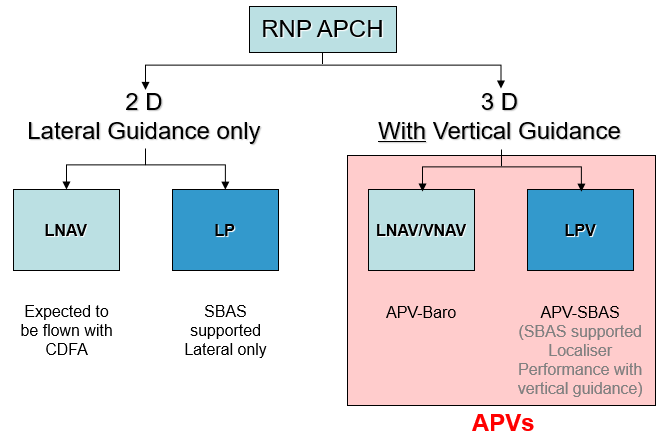In 2014, ICAO introduced a new methodology to differentiate between approach capabilities. Historically it was simple: Precision Approach (PA) and Non-Precision Approaches (NPA). The introduction of PBN approach capabilities with and without vertical guidance led ICAO to differentiate approach types by expected performance.

The term APproach with Vertical guidance (APV) was introduced by ICAO in 2007 when ICAO Resolution 36/23 was issued by the General Assembly.
Unfortunately, the initial PBN Manual did not reflect APVs in the two approach specifications RNP APCH and RNP (AR) APCH. In 2013 when the second edition of the PBN manual was published this oversight was corrected.
An APproach with Vertical guidance (APV) is, simply put, the vertical element of a RNP approach.
The only navigation sensor supporting RNP APCH is GNSS. This will either be GPS with ABAS or GPS with SBAS.
The diagram above shows the four possible options for the lines of minima of a RNP APCH. If the RNP APCH only has a lateral path defined, the minima for GPS with ABAS is LNAV (lateral navigation). If GPS with SBAS is planned to support the approach, then where vertical guidance cannot be assured a minima line entitled LP (Localiser Performance) could be published; this will not be a common minimum line and is likely to be limited to approaches supporting runways at very high latitudes or in deep East-West valleys where line of sight to the Geostationary satellite may be interrupted. If there is no vertical path defined, then the pilot is expected to fly a stabilised vertical path by applying a Continuous Descent Final Approach (CDFA) operation.
To improve safety and reduce the possibility of Controlled Flight Into Terrain (CFIT), the definition of a vertical path and guidance along that path should minimise the possibility of the loss of situational awareness (SA) on the approach path. When a lateral and vertical path is defined, the pilot will fly the approach just like a precision approach and the APV is flown to a decision altitude/decision height (DA/DH). Positioning on the lateral path is using augmented GPS and on the vertical path using either barometric altimetry (an APV Baro) or geometric altimetry (an APV SBAS).
An APV Baro uses GPS with ABAS for lateral position and barometric altimetry for vertical positioning is flown to a minima called LNAV/VNAV. An APV SBAS uses GPS augmented with SBAS for both lateral and vertical positioning and is flown to a LPV minima; the abbreviation LPV stands for Localiser Performance with Vertical Guidance.
There is one final important element that airspace users must be aware of. When the procedure designer defines a 2D, or lateral only, path to the runway, the designer calculates the minimum obstacle clearance altitude (MOCA) for that approach. The aircraft should not go below that altitude unless the pilot is visual. For a 3D approach, as the pilot will be 'heads down' to the DA/DH, the design of the procedure allows for height loss at that point if a missed approach must be initiated. This expected height loss is due to the time it will take for the engines to spool up and the aircraft to start to climb if a missed approach is initiated at DA/DH.
ICAO introduced Type A and Type B operations into Annex 6, Annex 10 and Annex 14. The table on the right details the diiferent types of approach operations.
Type A operations may be either 2D or 3D operations; 2D will only have a lateral path defined for the approach operation where 3D will have both a lateral and vertical path defined for that operation. A Type A operation will permit aircraft operations down to a minimum height or altitude of 250 ft. All NPAs and APprocahes with Vertical guidance (APV) using Barometic altimetry are Type A approach operations.

All Type B approach operations are 3D operations; a lateral and vertical path is defined and guidance along this path is provided either from GPS with SBAS (APV SBAS) or by a precision approach system.